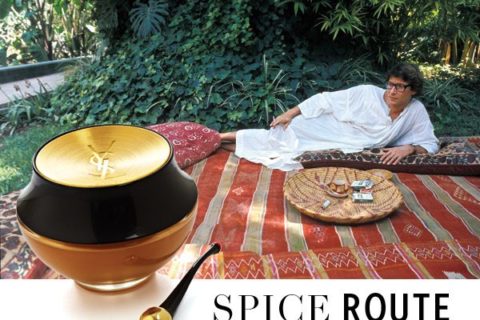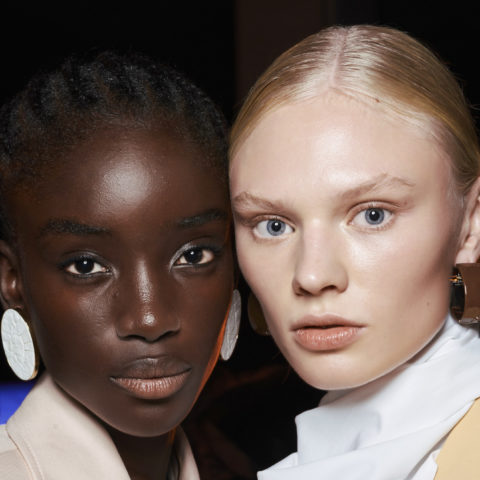Spice route: The history behind Yves Saint Laurent’s latest skincare development


Yves Saint Laurent found beauty and inspiration in Morocco, and now its natural bounty has yielded a precious skin-preserving ingredient known as red gold: saffron.
A young Yves Saint Laurent, looking relaxed and casual in a white open-necked shirt and white flares, strolls through Marrakech’s Djemaa El Fna square, chatting to a Marrakchi woman with a basket atop her head. It’s one of many personal snapshots from the book Yves Saint Laurent: Une Passion Marocaine, handwritten in French by his partner in business and life, Pierre Bergé. Saint Laurent was fascinated by the goings on in the square, often walking there to watch the acrobats, snake charmers and gnawa dancers who still bring life, music and art to the city today.
In February 1966, Saint Laurent and Bergé spent a few days in Marrakech on vacation, and fell so deeply in love with the city that by the time they boarded the four-hour flight home to Paris, they had decided to buy a house in the medina. From then on, the Algeria-born designer would retreat to Morocco on December 1 and June 1 every year to design his haute couture collections. Catherine Deneuve, Bianca Jagger, Andy Warhol and Talitha Getty came to stay, cementing Marrakech’s reputation for bohemian, hookah-fuelled glamour.
Immersing himself in the culture, Saint Laurent wore the traditional djellaba, shopped in the souks, collected indigenous Berber art and decorated his homes (three, over the years) with zellij tiles and local textiles. This influence soon appeared in his collections—in 1967, he showed African-inspired embroidered and beaded dresses. Saint Laurent found inspiration and a new kind of luxury in Morocco; so too have YSL’s skincare scientists some four decades later, sourcing the precious saffron threads that grow in the mountains outside Marrakech for Or Rouge Cream ($425, at Holt Renfrew).
Already deep into research on the role of glycobiology in skin aging, YSL’s R&D team began to search for a new ingredient that would further what they knew. Members of the sugar family, chemically speaking, glycans connect with various receptors in the surface of the skin to help cells with metabolism and communication—when those decline, the architecture of the skin deflates and protective mechanisms against free radicals, inflammation and melanin overproduction erode. What’s new is that this time, YSL researchers found a receptor that doesn’t decline with age.
“When the team discovered this glycan receptor that is stable, everyone was staring at the results, saying, ‘What’s happening? Is it true?’” says Véronique Guillou, the brand’s worldwide director for skincare development, sitting far from her lab in a draped tent at Kasbah Bab Ourika, a picturesque guesthouse surrounded by Berber villages and sweeping views of the Atlas mountains. “We know that glycans decrease with age, so [we thought] maybe this receptor is here but the natural key that could connect to it is the element missing. We looked for the key.”
After spending years studying the glycan content of a greenhouse worth of plants, the red saffron pistils that nestle inside purple crocus sativus flowers were identified as that missing key. Saffron grows in the Mediterranean region, southwest Asia and Africa, but in a happy accident, the saffron of Morocco’s High Atlas Mountains is packed with the right kind of glycan to keep the skin functioning. The arid, high-altitude area provides the ideal growing conditions—something known by the locals, who have long mixed saffron with argan oil, henna and rosewater for homemade skincare.
Although the oft-trotted-out maxim “saffron is more precious than gold” isn’t actually true, those red threads are rare, valuable and prized, particularly by Moroccan women.
The flowers are picked at dawn on one autumn morning a year, while the petals are still partially closed, enfolding the precious strands. This is women’s work, deft and delicate, and every October they gather where the flowers grow to wait and watch for the right moment. They sing as they work—according to local lore, the flowers rise from the ground to listen to their voices.
“In Morocco, once you step outside of the cities, people are mostly making a living off of agriculture,” says ethnobotanist Chris Kilham, who studies the relationship between people and plants. “Women in communities that harvest the crocus flowers depend very much on this for feeding their families. And if your husband dies, you can work in saffron.”
Kilham sees the increasingly competitive race to identify plants’ molecular activity for high-performance skincare as a perfect marriage of science and wisdom. “Nobody ever knew about the specifics of cellular regeneration as it refers to ingredients in saffron; you couldn’t have discovered that 25 years ago,” he says. “The evolution of science is now a spectacular companion to the natural ingredients that we’ve always had.”
Back in the bustling medina of Marrakech—on what is now Rue Yves Saint Laurent—is a vegetal oasis of another kind: Jardin Majorelle, the house and gardens conceived and cultivated by French artist Jacques Majorelle in the 1920s and bought and restored by Saint Laurent and Bergé in 1980. Against buildings, pots and pergolas painted striking “Majorelle blue” are cacti, palm trees, jasmine and bougainvillea from all over the world. A simple memorial to Saint Laurent sits in a leafy corner, as it’s here his ashes were scattered after his death in 2008.
Three years ago, the Pierre Bergé-Yves Saint Laurent Foundation turned Majorelle’s painting studio into a museum of Berber culture, featuring the couple’s collection of artifacts. This spring, it mounted an exhibition devoted to women of the Amazigh tribe. Lovingly displayed were their tools—for weaving, pottery and tapestry—as well as their adornments: henna, makeup, coral and amber necklaces, elaborately woven cloaks and belts worthy of a YSL haute couture collection. Women’s work, indeed.







